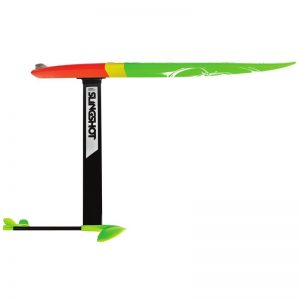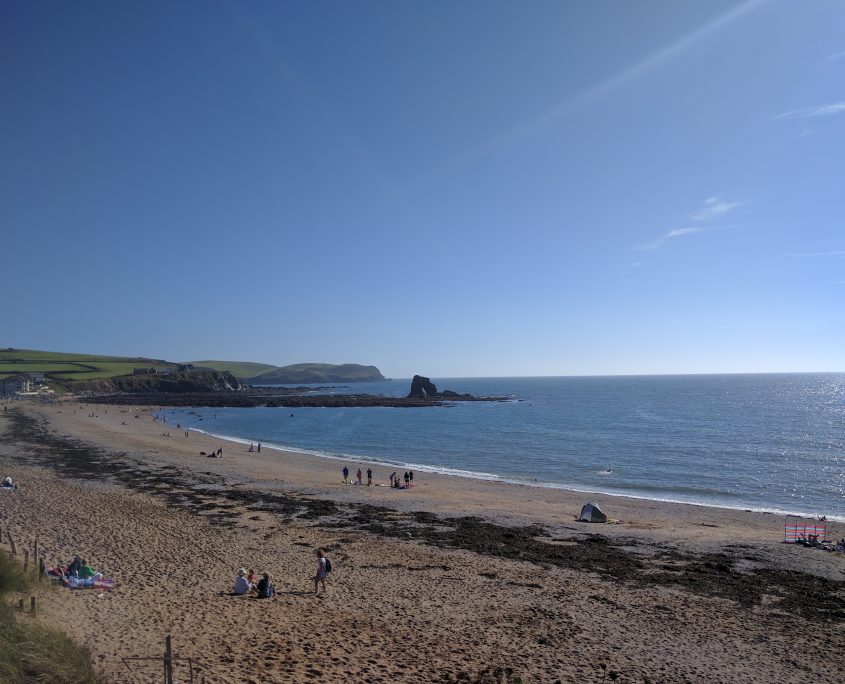
There’s no denying I am quite late to the hydrofoil party, with racers adopting it two or three years ago after the whole Olympic debacle and the discipline gradually working it’s way into the main stream with the kite manufacturers over the last year. I’ve purposefully held off getting one, as I had an ACL replacement and I wanted that to feel rock solid. I was also waiting for the prices to drop a bit and for something robust but not overly heavy to come along.
The beaches in close proximity to me are not overly foil friendly, with shallow water and surf at Bantham, and close chop, pointy reef and loads of weed at South Milton. After having a look at some of the carbon foils, I was confident I would probably destroy my £2k pride and joy fairly rapidly.
The Slingshot Dwarfcraft / Hover Glide NF2 appealed as it’s on the more reasonably priced side, is quite robust being a mixture of composite parts for the wing and aluminium for the mast. It has different mast heights which could help in shallower water. The wing parts are all quite modular and easily replaced. The marketing claims a less steep learning curve, starting with the shorter masts and working up to the full size.
I actually had a go on a Carafino foil (for about an hour) about ten years ago. I seem to remember it being very cumbersome, and hard to manipulate in the water but I got some runs on it, got thrown off and wobble along for while. I have done a lot of directional riding since then, so was fairly confident it wouldn’t be too hard. I ride a skim regularly in light wind which is quite front foot heavy and balance sensitive so wasn’t expecting it to be too much of a mission to get some runs on this green beast.
The foil arrived with the full sized mast initially (93cm) the smaller flight school masts will arrive within a week. I was far to excited to wait for them to turn up, so immediately built it up in the garage and cracked on. Building it is fairly simple, three M6 stainless bolts retain the front wing and tail section, and then two larger M8 pairs hold the mast to the wing and the board mount. They chuck in a couple of Allen keys, and it’s much easier to build than anything from Ikea, the instructions are quite concise. All the fittings on mine are very well finished. The casts and threads hooked together very easily with little of cross threading anything. The board itself is a EPS / glass affair and looks very snazzy with a concave deck and decent EVA pad. It’s lightish but could be more robust in my opinion, the age old trade off.
Session 1
Off I womble in the van to South Milton. It’s mid tourist season in the South Hams, the beaches are rammed. South Milton tends to be a little quieter and has protected area of deep and flat water behind a reef I have scoping out for this exact adventure. Also no one I knew would be there to watch me flounder (this didn’t quite work out) Conditions are far from ideal – it’s blowing about 12/13 knots bolt onshore and the chop is quite dense and about a foot high. The tide is too high for the flat section to expose itself. I rig a 10m Slingshot Wave SST on 23m lines as I have heard mixed things about how much power to use. I thought I would go for medium to low grunt factor. As instructed I used a single (and quite loose) front strap with luxurious leopard print.
Things I learnt in that first hour and a half:
- The most efficient way to body drag out to deeper water was to slide your chest onto the rear of the board and keep you weight on the windward corner to kick the leg out in front of you and keep the spiky bastard away from your body. I gripped the nose of the board as I was dealing with some grotty shore break and chop. I use a harness with a sliding spreader / rope setup so there’s no spreader bar or hook to bash into the board. This got me 40/50m out very quickly, enough for a couple of board start attempts with a decent level of grockle clearance. The upwind angle just body dragging is insane even with minimal power.
- The board pivots easily from the back, so twist if from the kick pad when you need to change tacks. Keep your feet out of the way of the wing, it’s bleddy sharp.
- Your next challenge is to roll the board towards you and get your feet in the straps. I did this by pushing the mast with one of my feet and them pulling the downwind rail towards me simultaneously to get the mast to the surface.
- Once you have the front foot in the strap you have enough leverage with you heal to keep it on the surface. I sat there for a bit, got my bearings, had a word with myself and thought about my take off angle.
- Dive the kite gently and keep your body compact, as soon as you pop up put your weight on your front foot and stand up. Don’t be tempted to try and edge, this will end in tears.
- To help me keep my weight forward I adopted quite a narrow stance initially with my back foot quite far forward. The board has a handy stripe through the EVA to help mark this.
- Don’t be afraid to abandon ship when things go pear shaped, fall off with good clearance of the board as it drifts pretty quick.
- Try and slow things down, relax your body and keep a neutral body position, make small balance inputs and don’t flap about.
- Park the kite and ignore it, concentrate on the board. I found diving the kite quite slowly to be beneficial.
By the end of this first session, I was making longer runs on the surface and starting to find the balance point on the wing for 10 – 20m. I was pretty tired from all the body dragging. When it does give you lift the feeling is effortless, silent and downright awesome. I left the beach exhausted, but very eager for more. It’s great to be humbled, and on the bottom of that learning curve again.



